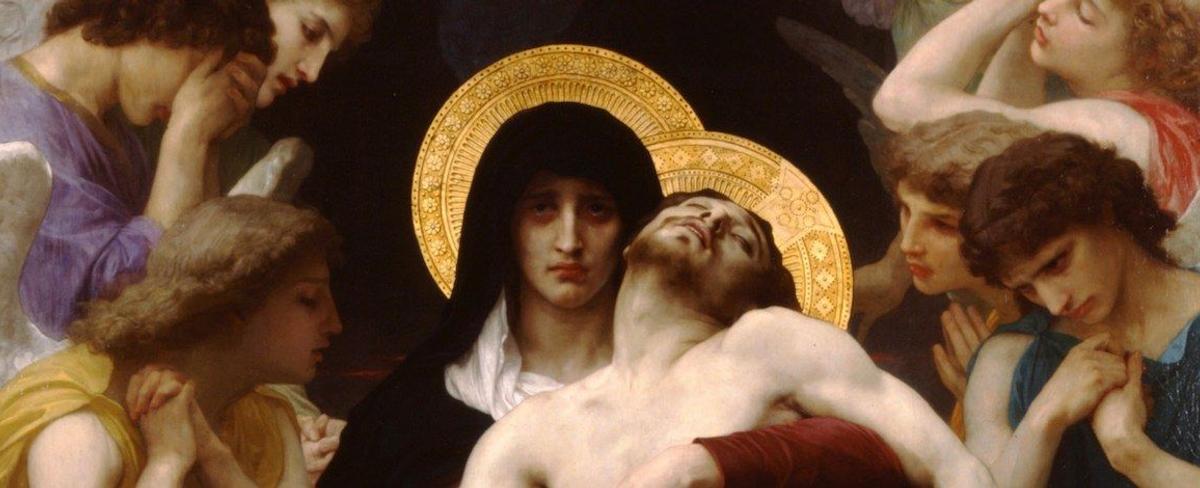Our Lady of Sorrows

As the Church celebrates the Feast of Our Lady of Sorrows (September 15), it is good to know the important role that Franciscans played in promoting this image of Mary and why.
The Cross of Christ was central to Francis and Clare, as we know from the impact of the image of San Damiano and from Francis’s prayer, “We adore you, Lord Jesus Christ, in all your churches throughout the whole world and we bless you, because my your holy cross you have redeemed the world.” In their preaching of penance, Franciscans promoted devotion to the suffering humanity of Jesus to draw people to conversion. It was important for them not simply that people should understand with their minds that Christ died on the cross for their sins, but that they convert their lives as a result. Therefore, Franciscan preachers wanted to touch peoples’ affections so that their hearts might be transformed and they would be motivated to choose the good.
However, “no matter how much the humanity of Christ was emphasized, it was still difficult for the contrite spirit to relate its own human responses of love or suffering to the figure on the cross while conscious of Christ’s divinity. Some referent for computing the nature of God’s love for humanity was required . . . the love and compassion of a human mother for her suffering child would naturally have a compelling emotional effect in actuating the conversion of the affections and move the heart to repentance. . . “ (David Jeffrey, The Early English Lyric & Franciscan Spirituality).
So, from the time of St. Anthony on, Franciscan preachers often focused on the suffering of Mary, standing in agony under the cross, to move Christians to repentance. The famous sequence Stabat Mater, used in the Church’s liturgy on this feast, is attributed to the Franciscan Jacopone of Todi, but even before this, St. Bonaventure wrote:
“What tongue can tell,
what intellect grasp
the heavy weight of your desolation,
Blessed Virgin?
You were present at all these events,
standing close by and participating in them
in every way.
This blessed and holy flesh –
which you so chastely conceived,
so sweetly nourished
and fed with your milk,
which you so often held on your lap,
and kissed with your lips –
You actually gazed upon
with your bodily eyes
Now torn by the blows of the scourges,
Now pierced by the points of the thorns. . .
Now pierced by nails and fixed to the wood of the cross. . .”
“’Jesus, my Son, Jesus permit me to die with you and for you, my son, oh sweetest Jesus!’
"Oh my God, good Jesus, my God crucified and put to death for me,
Grant me that feeling of compassion
which your innocent mother experienced
at the very hour of your passion.”
(Tree of Life, 28, 32; Mystical Vine, 9).
Image is a detail from a painting by William-Adolphe Bouguereau, in the Lady Chapel of the Cathedral of St. Louis, La Rochelle, Poitou-Charentes.
The Cross of Christ was central to Francis and Clare, as we know from the impact of the image of San Damiano and from Francis’s prayer, “We adore you, Lord Jesus Christ, in all your churches throughout the whole world and we bless you, because my your holy cross you have redeemed the world.” In their preaching of penance, Franciscans promoted devotion to the suffering humanity of Jesus to draw people to conversion. It was important for them not simply that people should understand with their minds that Christ died on the cross for their sins, but that they convert their lives as a result. Therefore, Franciscan preachers wanted to touch peoples’ affections so that their hearts might be transformed and they would be motivated to choose the good.
However, “no matter how much the humanity of Christ was emphasized, it was still difficult for the contrite spirit to relate its own human responses of love or suffering to the figure on the cross while conscious of Christ’s divinity. Some referent for computing the nature of God’s love for humanity was required . . . the love and compassion of a human mother for her suffering child would naturally have a compelling emotional effect in actuating the conversion of the affections and move the heart to repentance. . . “ (David Jeffrey, The Early English Lyric & Franciscan Spirituality).
So, from the time of St. Anthony on, Franciscan preachers often focused on the suffering of Mary, standing in agony under the cross, to move Christians to repentance. The famous sequence Stabat Mater, used in the Church’s liturgy on this feast, is attributed to the Franciscan Jacopone of Todi, but even before this, St. Bonaventure wrote:
“What tongue can tell,
what intellect grasp
the heavy weight of your desolation,
Blessed Virgin?
You were present at all these events,
standing close by and participating in them
in every way.
This blessed and holy flesh –
which you so chastely conceived,
so sweetly nourished
and fed with your milk,
which you so often held on your lap,
and kissed with your lips –
You actually gazed upon
with your bodily eyes
Now torn by the blows of the scourges,
Now pierced by the points of the thorns. . .
Now pierced by nails and fixed to the wood of the cross. . .”
“’Jesus, my Son, Jesus permit me to die with you and for you, my son, oh sweetest Jesus!’
"Oh my God, good Jesus, my God crucified and put to death for me,
Grant me that feeling of compassion
which your innocent mother experienced
at the very hour of your passion.”
(Tree of Life, 28, 32; Mystical Vine, 9).
Image is a detail from a painting by William-Adolphe Bouguereau, in the Lady Chapel of the Cathedral of St. Louis, La Rochelle, Poitou-Charentes.
Dominic Monti, OFM
Professor of Franciscan Research in the Franciscan Institute of St. Bonaventure University
Dominic V. Monti, OFM, is a Franciscan Friar of Holy Name Province (USA) and currently professor of Franciscan Research in the Franciscan Institute of St. Bonaventure University. He devoted the greater part of his ministry to teaching the History of Christianity, in particular the history of the Franciscan movement. He has contributed two volumes to the Works of St. Bonaventure series and is author of Francis & His Brothers, a popular history of the Friars Minor.

